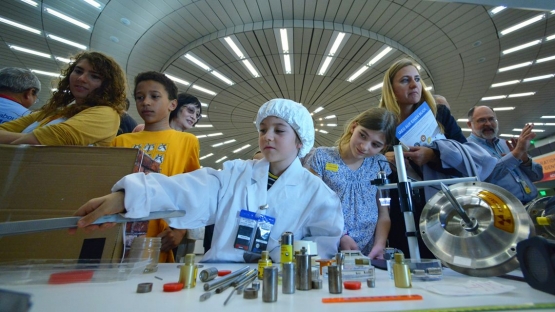At 16:45 on 22 April, eight-year-old Tariro stood outside Austria’s Vienna International Centre with her father and brother. The doors were about to open to the public interested in nuclear science and technology. Inside, IAEA scientists and engineers waited behind their exhibition booths with excitement.
A few minutes after 17:00, crowds filled the central rotunda of the United Nations compound in Vienna, flying from booth to booth as experts showcased their work with real insects, banana plants and luminescent marbles. U.S. Under Secretary of State Thomas Shannon was part of the crowd.
More than 1300 visitors of all ages entered during the course of the night, from retired scientists to young engineers to children like Tariro. “My favourite part was the banana stuff,” she said referring to a station where scientists explained how the IAEA is helping Member States save bananas from a deadly fungus by using radiation. When she grows up, she wants to be a scientist: “They get to explore many different, cool things.”
Tariro and her brother spent the evening at the Long Night of Research, an initiative of the Austrian government to foster interest in science and research. From 17:00 till close to midnight, more than 250 universities, museums, institutions and companies around the country put on more than 2000 evening exhibits to present their technologies in innovative and easy-to-understand ways. Youth is one main target audience of the event.
A major hit among children at the Vienna International Centre was the insect booth, with its basket traps of disease-transmitting mosquitoes and fruit fly-infested oranges. The booth demonstrated the sterile insect technique, a nuclear technique used to control insect populations. Ian, 17, and his friend Puneet, 15, said it was their favourite part of the evening because they learned that nuclear technology, when applied to fight Zika or malaria, could actually save lives. “It’s a lot of information,” Ian said, “and a lot of fun.”
A few metres away from the mosquitoes buzzing in their basket traps, visitors learned how IAEA safeguards inspectors detect undeclared nuclear activities. Children helped the inspectors swipe metal pieces with a special cloth, learning that the dust they had collected—invisible at first sight— glowed in the dark when placed under a special light. Using that same light, visitors searched a few luminescent marbles hidden in a box full of marbles of all sorts in what was a fun game that also demonstrated the basics of a method used by IAEA inspectors when they visit nuclear facilities around the world.
Discovering the secrets of nuclear science
Visitors bombarded the experts with questions about the details of each process, the science behind each method, as well as the legal and environmental sides of nuclear power.
“Events like this provide a good opportunity to show the world what the IAEA does,” said Aldo Malavasi, IAEA Deputy Director General and Head of the Department of Nuclear Sciences and Applications. “Visitors can see for themselves that the IAEA works in a wider range of areas than they think: helping people stay healthy, treating cancer, measuring air pollution or ocean acidification are just some examples.”
Visitors also had the opportunity to listen to IAEA experts giving short, illustrated talks to explain how nuclear power can help combat climate change, why managing soil is so important, how the sterile insect technique is used and how the IAEA works to reduce the global use of high enriched uranium.
“There was clear involvement from both sides: an interested audience on one side and motivated IAEA scientists on the other,” said Susanna Lööf, Press and Public Information Officer at the IAEA who coordinated the event. “Both groups share the same passion for science, which is why we had such good interactions.”
It was the first time the IAEA participated in this event, together with the Comprehensive Test-Ban Treaty Organization, the United Nations Office for Outer Space Affairs and the United Nations Industrial Development Organization.



